Why HNIs Are Increasingly Allocating to Bonds in 2025
17 November 2025

Market Volatility Is Shaping More Balanced Portfolios
High-Net-Worth Individuals (HNIs) in India are rebalancing their portfolios in 2025 with a noticeable shift toward bonds and other fixed-income instruments. This shift is not accidental—it reflects broader market conditions, evolving risk preferences, and the growing maturity of India’s bond market ecosystem.
As platforms like BondScanner make bond discovery and execution more transparent and accessible, HNIs are taking a more structured approach to fixed-income investing. This article explores the key reasons behind this trend, grounded in data, market behaviour, and regulatory developments—without offering any investment advice or predictions.
2024–2025 has been a period of heightened market fluctuations driven by global economic uncertainty, geopolitical developments, and shifting interest rate cycles. While equities continue to be a major component of HNI portfolios, many are seeking stability through asset classes that historically exhibit lower volatility.
Bonds—whether government securities, corporate bonds, or market-listed NCDs—act as stabilizers across market cycles. Their predictable cash flows (via coupons), defined tenures, and structured repayment frameworks help investors balance short-term volatility with long-term goals.
This gradual shift is not about replacing equities but complementing them to achieve diversification.
Fixed-Income Instruments Are Becoming More Accessible
Until a few years ago, access to high-quality fixed-income products was limited to institutional investors, private wealth desks, and family offices. Today, the bond market is far more transparent:
Regulated online platforms (SEBI OBPPs) offer direct access to listed bonds.
Exchange-based order placement ensures standardized settlement procedures.
Investors can explore instruments across credit ratings, coupon structures, and maturities.
Platforms like BondScanner simplify the process by offering structured information—yield, coupon, credit rating, issuer details, and tenure—helping investors make independent evaluations.
This increased accessibility is one of the biggest drivers behind higher HNI participation in the bond markets.
Diversification Beyond Traditional Assets
HNIs have traditionally relied on equities, real estate, and private equity. However, portfolio construction trends in 2025 show a deliberate shift toward:
Government securities (G-Secs)
Corporate bonds
Market-linked debentures
Infrastructure bonds
Perpetual bonds (educational illustrations only)
These instruments offer exposure to different sectors and credit profiles. For example, some may explore infrastructure-related bonds to balance growth and stability, while others may consider high-credit corporate bonds for predictable coupon flows.
This multi-layered diversification reduces concentration risk without compromising long-term goals.
Interest Rate Cycle Stabilization Is Attracting Attention
As India enters a more stable interest rate environment, many HNIs see value in locking in yields available across varying tenures.
While interest rate movements can affect bond prices, the clarity around rate cycles has encouraged investors to explore fixed-income allocations with greater confidence.
Again, this does not indicate or guarantee returns—rather, it reflects a more systematic approach to how wealthy investors are planning for medium- to long-term financial goals.
Regulatory Enhancements Are Building Investor Confidence
SEBI and RBI have consistently strengthened the bond market ecosystem:
Enhanced disclosure norms for issuers
Exchange-based order flow
Increased transparency in corporate bond markets
Frameworks supporting liquidity and settlement confidence
These improvements reduce information gaps, a major reason why HNIs feel more comfortable assessing and tracking their fixed-income investments today.
Structured Cash Flow Planning Is a Priority for HNIs
For many wealthy investors, capital preservation and consistent cash flows are essential. Bonds—especially those with periodic coupons—provide structured payouts at predefined intervals.
These predictable cash flows help HNIs:
Manage liquidity
Plan for business expansions
Support estate or succession planning
Maintain long-term capital efficiency
This is especially important for entrepreneurs, family offices, and business owners who prefer steady income streams to support personal or business cash flow cycles.
Technology Is Transforming the Bond-Selection Experience
Platforms like BondScanner have changed how investors interact with the bond market. HNIs today expect:
Streamlined discovery and comparison
Real-time yield and price tracking
Rich issuer disclosures
Simplified settlement workflows
While these tools do not provide personalized advice, they enable investors to independently analyse fixed-income opportunities.
Digital adoption is one of the biggest catalysts behind the rise in bond participation among affluent investors.
Bonds Help Strengthen Core Portfolio Foundations
HNIs increasingly view bonds as anchor assets—components that hold the portfolio steady during uncertain times.
Whether it is a laddering strategy, diversifying maturities, or balancing risk with higher-rated debt instruments (for illustration only), bonds can help create a resilient financial foundation.
This does not imply any guaranteed outcomes, but simply reflects how investors are structuring their portfolios more holistically in 2025.
FAQs
1. Why are HNIs showing interest in bonds in 2025?
HNIs are focusing on bonds due to market volatility, stable cash flows, improved accessibility, regulatory clarity, and the rise of digital platforms that simplify bond investing.
2. Are bonds suitable only for risk-averse investors?
Not necessarily. Bonds are used by different types of investors for diversification, stability, or structured payouts, depending on individual financial goals. They are not exclusive to any single risk profile.
3. What types of bonds do HNIs typically explore?
HNIs may explore government securities, corporate bonds, listed NCDs, and other fixed-income instruments. These are considered based on factors like tenure, credit rating, and yield structure.
4. Do bonds guarantee returns?
No. Even though bonds may offer predictable coupon structures, all investments carry risks, including credit risk, interest rate risk, and liquidity risk.
5. Is BondScanner providing investment advice?
No. BondScanner is a SEBI-registered OBPP (Online Bond Platform Provider) and does not offer personalized investment advice. The platform provides transparent access and information to help investors evaluate bonds independently.
Disclaimer
This blog is intended solely for educational and informational purposes. The bonds and securities mentioned herein are illustrative examples and should not be construed as investment advice or personal recommendations. BondScanner, as a SEBI-registered Online Bond Platform Provider (OBPP), does not provide personalized investment advice through this content.
Readers are advised to independently evaluate investment options and seek professional guidance before making financial decisions. Investments in bonds and other securities are subject to market risks, including the possible loss of principal. Please read all offer documents and risk disclosures carefully before investing.
Recent Blogs

Taxation on Bonds in India
A Detailed Overview of How Different Bonds Are Taxed in India.
14 Nov 2025

Corporate Bond vs Fixed Deposit Returns
A Comprehensive Comparison of Two Popular Fixed-Income Investments in India.
13 Nov 2025

Introducing the New BondScanner: Investing Made Simple, Compliant, and Seamless
A fully digital, SEBI-compliant investing experience built for trust, transparency, and simplicity.
13 Nov 2025